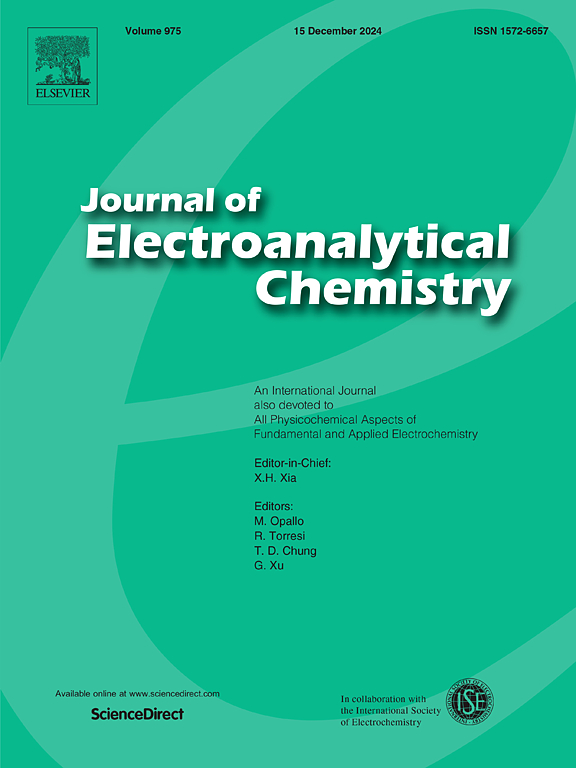Bromide crossover through various perfluorinated cation-exchange membranes in the presence of two cationic components in solution
IF 4.1
3区 化学
Q1 CHEMISTRY, ANALYTICAL
引用次数: 0
Abstract
Chronoamperometry and steady-state voltammetry data for a specially designed working electrode composed of a Pt disk covered mechanically with various perfluorinated cation-exchange membranes in contact with an external 2 M sulfuric acid solution with addition of various NaBr concentrations have been employed to estimate crossover parameters of bromide ions in relation to redox-flow battery applications. This technically simple but efficient approach has allowed us to determine the values of the diffusion coefficient of the electroactive Br− co-ion inside each membrane and of its equilibrium distribution coefficient between the membrane and the outer solution via an express experimental procedure and subsequent simple calculations. These crossover parameters of bromide co-ions have been found for Nafion NR211, Nafion XL, Nafion NR212, Nafion N115, Nafion N117 as well as GP-IEM-103, GP-IEM-105 membranes. Correlation of the steady-state diffusion-limited current due to the bromide oxidation both with its concentration in the outer solution and with the membrane thickness has been analyzed. It has been established that the transport characteristics of the bromide anion are close to each other for all homogeneous membranes under study in contact with a mixed X M NaBr +2 M H2SO4 solution (the value of X varies between 0.125 and 0.75): their values belong to the range from 2.6 10−6 cm2 s−1 to 3.4 10−6 cm2 s−1 for its diffusion coefficient inside membrane and to the range from 0.13 to 0.18 for its distribution coefficient at the membrane/solution boundary. Compared to the homogeneous membranes, the Br− anion diffusion inside the heterogenous (Nafion XL) membrane is slower and there is a tendency to its accumulation to a larger amount. Comparison of these results for Nafion NR212 in contact with the NaBr+H2SO4 solution with those previously obtained for the same membrane in contact with the HBr + H2SO4 solution has allowed us to conclude that the applied approximate treatment of experimental data based on the theory of molecular-diffusion transport of this co-ion inside the membrane (without taking into account the migration contribution to the bromide flux owing to the suppression of the electric field by highly mobile H+ cations) remains applicable for systems where the NaBr concentration inside the external solution does not exceed 0. 75 M.
溴化物在溶液中存在两种阳离子组分时通过各种全氟阳离子交换膜进行交叉
采用计时安培法和稳态伏安法数据对一个特殊设计的工作电极进行了研究,该工作电极由机械覆盖各种全氟阳离子交换膜的铂盘组成,与加入各种NaBr浓度的外部2 M硫酸溶液接触,用于估计与氧化还原液流电池应用相关的溴离子交叉参数。这种技术上简单但有效的方法使我们能够通过一个明确的实验程序和随后的简单计算来确定膜内电活性Br - co离子的扩散系数和膜与外溶液之间的平衡分配系数的值。在Nafion NR211、Nafion XL、Nafion NR212、Nafion N115、Nafion N117以及GP-IEM-103、GP-IEM-105膜上均发现了溴化物共离子的交叉参数。分析了溴化物氧化引起的稳态限扩散电流与外溶液浓度和膜厚度的关系。它建立了溴离子的运输特点相互接近所有均匀膜下研究接触X M NaBr + 2 M硫酸溶液混合(X的值在0.125和0.75之间变化):他们的价值观属于范围从2.6 10−6平方厘米−1到3.4 10−6 cm2年代−1的膜内扩散系数和分配系数的范围从0.13到0.18在膜/边界的解决方案。与均相膜相比,非均相(Nafion XL)膜内Br -阴离子的扩散速度较慢,且有大量积累的趋势。将与NaBr+H2SO4溶液接触的Nafion NR212的结果与先前获得的与HBr +H2SO4溶液接触的相同膜的结果进行比较,使我们得出结论,基于膜内该共离子的分子扩散输运理论对实验数据进行了近似处理(没有考虑由于高流动性H+对电场的抑制而对溴化物通量的迁移贡献)(阳离子)仍然适用于外部溶液内NaBr浓度不超过0的系统。75米。
本文章由计算机程序翻译,如有差异,请以英文原文为准。
求助全文
约1分钟内获得全文
求助全文
来源期刊
CiteScore
7.80
自引率
6.70%
发文量
912
审稿时长
2.4 months
期刊介绍:
The Journal of Electroanalytical Chemistry is the foremost international journal devoted to the interdisciplinary subject of electrochemistry in all its aspects, theoretical as well as applied.
Electrochemistry is a wide ranging area that is in a state of continuous evolution. Rather than compiling a long list of topics covered by the Journal, the editors would like to draw particular attention to the key issues of novelty, topicality and quality. Papers should present new and interesting electrochemical science in a way that is accessible to the reader. The presentation and discussion should be at a level that is consistent with the international status of the Journal. Reports describing the application of well-established techniques to problems that are essentially technical will not be accepted. Similarly, papers that report observations but fail to provide adequate interpretation will be rejected by the Editors. Papers dealing with technical electrochemistry should be submitted to other specialist journals unless the authors can show that their work provides substantially new insights into electrochemical processes.

 求助内容:
求助内容: 应助结果提醒方式:
应助结果提醒方式:


